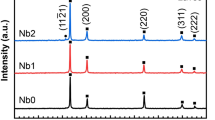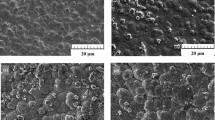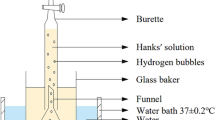Abstract
The protective capabilities of sol–gel coatings are determined by their physical barrier properties. For an effective protection, a homogenous crack-free material is required, which prevents from attacks of corrosive species. When the coating is damaged, active corrosion protection is usually achieved by the use of inhibitors. Among the different inhibitors rare earth ions and especially cerium have shown effective inhibiting properties. Due to the complexity of the corrosion processes, a combination of inhibitors is expected to be superior to a monocomponent inhibiting. The aim of this study was to prove which other ions, used in combination with cerium, can improve the corrosion protection abilities of hybrid silica based inorganic–organic sol–gel coatings applied on aluminium alloy 2024 substrates. Mixtures of cerium nitrate with two other potential inhibitor substances were incorporated into a sol–gel matrix and their behaviour in neutral salt spray test and during EIS measurements was investigated. The Ce–P–Pr inhibitor combination (Ce3+, PO4 3−, Pr3+) has shown the best long-term corrosion protection properties at low doping levels.















Similar content being viewed by others
References
Duffus JH (2005) Chemical speciation terminology: chromium chemistry and cancer. Miner Mag 69(5):557–562
Caglieri A, Goldoni M, Acampa O, Andreoli R, Vettori MV, Corradi M, Apostoli P, Mutti A (2006) The effect of inhaled chromium on different exhaled breath condensate biomarkers among chrome-plating workers. Environ Health Perspect 114(4):542–546
Metroke TL, Kachurina O, Knobbe ET (2002) Spectroscopic and corrosion resistance characterization of amine and super acid-cured hybrid organic-inorganic thin films on 2024-T3 aluminum alloy. Prog Org Coat 44:185–199
Zhandi-Zand R, Ershad-Langroudi A, Rahini A (2005) Silica-based organic-inorganic hybrid nanocomposite coatings for corrosion protection. J Non-Cryst Solids 351:1307–1311
Liu Y, Sun D, You H, Chung JS (2005) Corrosion resistance properties of organic–inorganic hybrid coatings on 2024 aluminium alloy. Appl Surf Sci 246:82–89
Lampke T, Darwich S, Wielage B, Steinhäuser S (2008) Cost-efficient conversion coatings for corrosion protection prepared by the sol–gel process. Materialwiss Werksttech 39:460–465
Wu KH, Chang YC, Yang CC, Gung YJ, Yang FC (2009) Synthesis, infrared stealth and corrosion resistance of organically modified silicate-polyaniline/carbon black hybrid coatings. Eur Polym J 45:2821–2829
Zheludkevich ML, Yasakau KA, Poznyak SK, Ferreira MGS (2005) Triazole and thiazole derivatives as corrosion inhibitors for AA2024 aluminium alloy. Corros Sci 47:3368–3383
Khramov AN, Voevodin NN, Balbyshev VN, Manz RA (2005) Sol–gel-derived corrosion-protective coatings with controllable release of incorporated organic corrosion inhibitors. Thin Solid Films 483:191–196
Quinet M, Neveu B, Moutarlier V, Audebert P, Ricq L (2007) Corrosion protection of sol–gel coatings doped with an organic corrosion inhibitor. Chloranil. Prog Org Coat 58:46–53
Shchukin DG, Lamaka SV, Yasakau KA, Zheludkevich ML, Ferreira MGS, Möhwald H (2008) Active anticorrosion coatings with halloysite nanocontainers. J Phys Chem C 112:958–964
Kasten LS, Grant JT, Grebasch N, Voevodin N, Arnold FE (2001) An XPS study of cerium dopants in sol–gel coatings for aluminum 2024-T3. Surf Coat Technol 140:11–15
Pepe A, Aparicio M, Cere S, Duran A (2004) Preparation and characterization of cerium doped silica sol–gel coatings on glass and aluminium substrate. J Non-Cryst Solids 348:162–171
Shi HW, Liu FC, Han EH, Sun MC (2006) Investigation on a sol-gel coating containing inhibitors on 2024-T3 aluminum alloy. Chin J Aeronaut 19:106–112
Hamdy AS (2006) Advanced nano-particles anti-corrosion ceria based sol gel coatings for aluminum alloys. Mater Lett 60:2633–2637
Wang H, Akid R (2007) A room temperature cured sol–gel anticorrosion pre-treatment for Al 2024-T3 alloys based sol gel coatings for aluminum alloys. Corros Sci 49:4491–4503
Rosero-Navarro NC, Pelice SA, Duran A, Aparicio M (2008) Effects of Ce-containing sol–gel coatings reinforced with SiO2 nanoparticles on the protection of AA2024. Corros Sci 50:1283–1291
Yasakau KA, Zheludkevich ML, Karavai OV, Ferreira MGS (2008) Influence of inhibitor addition on the corrosion protection performance of sol–gel coatings on AA2024. Prog Org Coat 63:352–361
Moutarlier V, Neveu B, Gigandet MP (2008) Evolution of corrosion protection for sol–gel coatings doped with inorganic inhibitors. Surf Coat Technol 202:2052–2058
Schem M, Schmidt T, Gerwan J, Wittmar M, Veith M, Thompson GE, Molchan IS, Hashimoto T, Skeldon P, Phani AR, Santucci S, Zheludkevich ML (2009) CeO2-filled sol–gel coatings for corrosion protection of AA2024-T3 aluminium alloy. Corros Sci 51:2304–2315
Zaharescu M, Predoana L, Barau A, Raps D, Gammel F, Rosero-Navarro NC, Castro Y, Duran A, Aparicio M (2009) SiO2 based hybrid inorganic–organic films doped with TiO2–CeO2 nanoparticles for corrosion protection of AA2024 and Mg-AZ31B alloys. Corros Sci 51:1998–2005
Chambers BD, Taylor SR (2007) The high throughput assessment of aluminium alloy corrosion using fluorometric methods. Part II—A combinatorial study of corrosion inhibitors and synergistic combinations. Corros Sci 49:1597–1609
Wittmar A, Wittmar M, Caparrotti H, Veith M (2011) The influence of the inhibitor particle sizes to the corrosion properties of hybrid sol–gel coatings. J Sol–Gel Sci Technol 59:621–628
Jonschker G, Langenfeld S, Schmidt H (2002) Method for protecting metallic substrate against corrosion, Patent No. US6403164B1
Van Laar JAW (1961) Die Unterrostung von lackiertem Stahl. Dtsch Farbenzeitschrift 15:56–67 and 104–117
Acknowledgments
This work was realised in the context of the MULTIPROTECT project, funded within the sixth Framework Programme of the European Community (Contract No NMP3-CT-2005-011783). We thank Dr. Mesut Aslan and Dr. Marcus Koch for preparing the cross sections and taking SEM images.
Author information
Authors and Affiliations
Corresponding author
Rights and permissions
About this article
Cite this article
Wittmar, A., Wittmar, M., Ulrich, A. et al. Hybrid sol–gel coatings doped with transition metal ions for the protection of AA 2024-T3. J Sol-Gel Sci Technol 61, 600–612 (2012). https://doi.org/10.1007/s10971-011-2666-6
Received:
Accepted:
Published:
Issue Date:
DOI: https://doi.org/10.1007/s10971-011-2666-6




